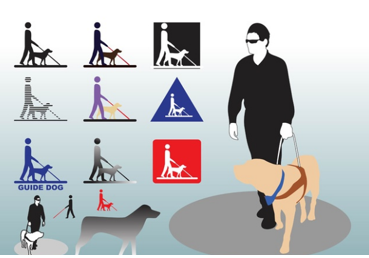Guide Dogs for Blind and Partially Sighted People
Guide dogs help people who are blind or visually impaired move around safely, and often transform their lives. They are usually allowed anywhere that the public can go, even where dogs aren’t allowed. In the United States, guide dogs are called Seeing Eye dogs. Guide dogs must learn not to obey any command that might put their owner in danger. This is perhaps the most amazing thing about guide dogs; they know when to follow their owner’s commands and when they should disobey their owner to keep them safe. This is very important at road crossings, where the owner and dog must work very closely together to cross safely. When they reach the kerb, the dog stops and signals to the owner that they have reached a crossing.
Dogs cannot recognize the colour of traffic lights, so the owner must decide when it is safe to cross the road. The owner listens to the flow of traffic to decide when the light has changed, and then gives the command “forward”. If there’s no danger, the dog crosses the road. If there are cars coming, the dog waits until they pass and then crosses. The guide dog doesn’t know where they are going, so it must follow the owner’s instructions. The owner can’t see obstacles, so the guide dog must help the owner to avoid them.
Not all dogs can adapt to the life of a guide dog. Puppies born to be guide dogs have to be intelligent and good-natured; it’s important that they aren’t nervous of crowds or frightened by sudden noises. When it is eight weeks old, the puppy sets out on its journey to become a guide dog. It goes to live with a volunteer “puppy-walker”, who teaches the puppy to follow simple commands and to walk on a lead. The puppy-walker also takes it to busy town centres and on different kinds of public transport. The puppy is introduced to the sights, sounds and smells of a world in which it will play such an important part.
When the puppy is about a year old, it returns to the guide dog centre for the next part of its training. It can be hard for puppy-walkers to say goodbye to a puppy, but they have the satisfaction of knowing they have helped to raise a dog that will one day be someone’s eyes. Guide dogs work hard and there’s no room for fun during the working day. If you see a guide dog, you should leave it alone so that it can concentrate on helping its owner. At the end of the day, however, a guide dog will play just like an ordinary pet.

